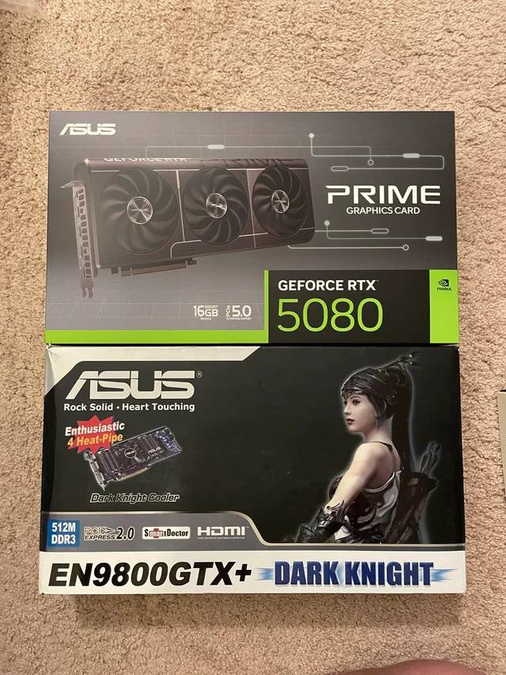When you think of the cutting-edge graphics cards of today, the RTX 5080 is likely top of mind—sleek, powerful, and undeniably advanced. But what happens when you put it side by side with a 16-year-old graphics card? A surprising discovery emerges that sheds light on how far we’ve come… and yet, how little has changed in some aspects.
The Aesthetic Evolution of Graphics Card Packaging
If you were to flash back to 2009, the packaging for graphics cards was a work of art in itself. Companies like ASUS, MSI, and XFX went all out to make their boxes not only functional but also striking. Imagine fierce, futuristic creatures and wild, elaborate designs—all meant to grab your attention on a store shelf. These graphics card boxes were as much a marketing tool as the hardware itself, showcasing the power of the product within.
Fast forward to today, and the contrast is stark. After comparing the new RTX 5080 with the older EN9800GTX+ released in 2009, one thing immediately stands out: the size of the boxes hasn’t changed. Yes, the dimensions are identical. But the design? That’s where the biggest change has occurred. Gone are the oversized, colorful graphics and detailed illustrations. In their place, you’ll find minimalist designs with sleek logos and clear-cut specifications.
Some long-time enthusiasts might be left feeling nostalgic, reminiscing about a time when the packaging of a graphics card made a bold statement. I can’t help but agree with the sentiment—those vibrant, creative designs gave us something more than just the product inside; they gave us a sense of excitement and anticipation about the power we were about to unlock.

Why the Change in Design ?
So why did the aesthetics of graphics card packaging shift so dramatically over the years? There are a few key reasons behind this transformation. First, the market has evolved, and so have the buying habits of consumers. In the past, shoppers would stroll through brick-and-mortar stores, and the visual appeal of packaging could make or break a sale. But with online shopping now dominating, brands no longer need to compete for shelf space with flashy packaging. Instead, online reviews, benchmarks, and detailed product tests are the primary tools influencing purchasing decisions.
Second, there’s the cost factor. As manufacturers look for ways to streamline their processes and reduce expenses, packaging has become a target for simplification. Fewer colors, less intricate graphics, and a more standardized printing process have all contributed to cost-saving measures. While these changes may make the packaging less visually engaging, they allow companies to focus more on the core technical aspects of the product itself, ensuring the performance is the main selling point.
But here’s the paradox that stood out during this comparison: as technology in graphics cards has evolved rapidly, the boxes themselves have stayed nearly the same size—just without the flash and character that once made them so exciting.
A Glimpse of the Past vs. the Present
While the modern-day RTX 5080 is a powerhouse of technology, there’s something undeniably charming about the old-school packaging of yesteryear. It was an era where companies didn’t just sell you hardware; they sold you an experience, a glimpse into the future of gaming and computing. As we move toward more streamlined, cost-effective designs, I can’t help but feel a twinge of loss for those bold, dramatic boxes.
For some, the packaging might seem like a trivial detail, but to those who remember the excitement of unboxing a new graphics card, those flashy designs were a reminder of the revolution happening inside the box.
In the end, even as graphics technology continues to advance at breakneck speed, there’s a reminder here: Sometimes the most memorable moments aren’t about the product itself, but about how it made us feel when we first laid eyes on it. Whether you’re upgrading to the RTX 5080 or reminiscing about the good ol’ days of eye-catching packaging, one thing is certain: the world of graphics cards is constantly evolving.





